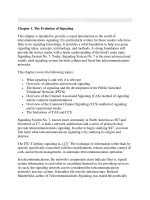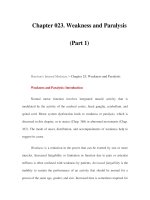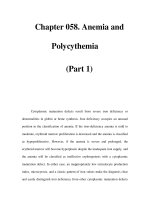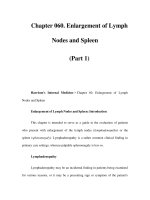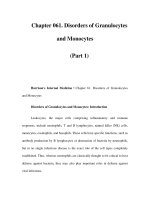Cephalometry A Color Atlas and Manual - part 1 pps
Bạn đang xem bản rút gọn của tài liệu. Xem và tải ngay bản đầy đủ của tài liệu tại đây (2.32 MB, 37 trang )
Gwen R.J. Swennen
Filip Schutyser · Jarg-Erich Hausamen
Three-Dimensional Cephalometry
A Color Atlas and Manual
Gwen R.J. Swennen
Filip Schutyser
Jarg-Erich Hausamen
Three-Dimensional
Cephalometry
A Color Atlas and Manual
With 713 Figures, mostly in Colors and 6 Tables
123
Gwen R.J. Swennen, MD DMD PhD
Associate Professor
Department of Oral and Maxillofacial Surgery
Medizinische Hochschule Hannover
Hannover, Germany
and
Consultant Surgeon
Department of Plastic Surgery
University Hospital Brugmann
and Queen Fabiola Children’s University Hospital
Brussels, Belgium
Filip Schutyser,MSc
Research Coordinator
Medical Image Computing (Radiology – ESAT/PSI)
Faculties of Medicine and Engineering
University Hospital Gasthuisberg
Leuven, Belgium
Jarg-Erich Hausamen, MD DMD PhD
Former Professor and Chairman
Department of Oral and Maxillofacial Surgery
Medizinische Hochschule Hannover
Hannover, Germany
Library of Congress Control Number: 2005929880
This work is subject to copyright. All rights are reserved, whether the
whole or part of the material is concerned, specifically the rights of
translation, reprinting, reuse of illustrations, recitation, broadcasting,
reproduction on microfilm or in any other way, and storage in data
banks.Duplication of this publication or parts thereof is permitted only
under the provisions of the German Copyright Law of September 9,
1965, in its current version, and permission for use must always be
obtained from Springer-Verlag. Violations are liable for prosecution
under the German Copyright Law.
Springer is a part of Springer Science +
Business Media
springeronline.com
© Springer-Verlag Berlin Heidelberg 2006
Printed in Germany
ISBN-10 3-540-25440-4 Springer Verlag Berlin Heidelberg New York
ISBN-13 978-3-540-25440-9 Springer Verlag Berlin Heidelberg New York
The use of general descriptive names,registered names,trademarks, etc.
in this publication does not imply,even in the absence of a specific state-
ment, that such names are exempt from the relevant protective laws and
regulations and therefore free for general use.
Product liability: The publishers cannot guarantee the accuracy of any
information about dosage and application contained in this book. In
every individual case the user must check such information by consult-
ing the relevant literature.
Editor: Gabriele Schröder, Springer-Verlag, Heidelberg
Desk editor: Martina Himberger, Springer-Verlag, Heidelberg
Production: ProEdit GmbH, Elke Beul-Göhringer, Heidelberg
Cover design: Estudio Calamar, F. Steinen-Broo,
Pau/Girona, Spain
Typesetting and reproduction of the figures:
AM-productions GmbH, Wiesloch
Printed on acid-free paper
24/3151beu-göh 543210
This book is dedicated to
my wife Valérie and my son Joaquin.
Gwen R.J. Swennen
VII
Radiographic cephalometry has been one of the most
important diagnostic tools in orthodontics, since its
introduction in the early 1930s by Broadbent in the
United States and Hofrath in Germany. Generations of
orthodontists have relied on the interpretation of these
images for their diagnosis and treatment planning as
well as for the long-term follow-up of growth and
treatment results. Also in the planning for surgical
orthodontic corrections of jaw discrepancies, lateral
and antero-posterior cephalograms have been valu-
able tools. For these purposes numerous cephalomet-
ric analyses are available. However, a major drawback
of the existing technique is that it renders only a two-
dimensional representation of a three-dimensional
structure.
It was almost 75 years before the next step could
be taken in the use of cephalometrics for clinical and
research purposes. The development of computed
tomography and the dramatic decrease in radiation
dose of the newer devices brings three-dimensional
analysis of the head and face to the scene.A major step
forward is also that 3D hard and soft tissue representa-
tions can be combined in the same image, which
enables in depth analysis of these tissues in relation to
each other possible.
With “Three-Dimensional Cephalometry – A Color
Atlas and Manual” by the authors Swennen, Schutyser
and Hausamen you have an exciting book in your
hands. It shows you how the head can be analysed in
three dimensions with the aid of 3D-cephalometry.
Of course,at the moment the technique is not available
in every orthodontic office around the corner. How-
ever, especially for the planning of more complex
cases where combined surgical – orthodontic treat-
ment is indicated,it is my sincere conviction that with-
in 10 years time 3D cephalometry will have changed
our way of thinking about planning and clinical
handling of these patients.
July 2005 Anne Marie Kuijpers-Jagtman,
DDS, PhD, FDSRCS Eng
Professor and Chair
Department of Orthodontics
and Oral Biology
Radboud University Nijmegen
Medical Centre
Nijmegen, The Netherlands
Foreword
IX
Few can fail to feel enlivened by entering a bookshop,
and to encounter a new surgical textbook always pro-
vokes excitement. I am therefore most honoured to be
asked to pen this foreword to what is truly a new book.
This is not just a rehashing of old ideas on familiar top-
ics, but a most innovative exploration of an increasing-
ly important diagnostic medium, 3-D imaging.
We have all been assailed by sometimes startling
3-D images, but on cooler reflection have realised these
were no more than clever pictures, of little value to
patient or clinician. This book, however, provides a
logical comprehensive text on the role of 3-D imaging
in the surgical management of facial deformity. It skil-
fully provides a range of knowledge from the basic
principles of radiological imaging to its use, giving the
patients the best options for a predictable and good
outcome. Seeing the list of authors, it should come as
no surprise that this is innovative and highly informa-
tive. Professor Jarg-Erich Hausamen has established
a centre of excellence for maxillofacial surgery. His
modest persona, coupled with his great depth of
knowledge and teaching skills,has made his unit an in-
ternational name for innovation, training and, above
all, patient care. It is not surprising, therefore, that his
co-authors and former colleagues have shown tireless
dedication in the production of this book.
It is clear that 3-D imaging has become an essential
tool in planning and managing the treatment of facial
deformity. The development of spiral CT and cone
beam CT has revolutionised this technique, the former
providing outstanding resolution and the latter, with
its low cost, allowing unique accessibility. Both tech-
niques reduce radiation levels to permit use in non-
life-threatening conditions, such as facial deformity.
These technological advances would be worthless,
however, without this type of comprehensive textbook.
This book educates and is a source of reference for all
surgeons,regardless of seniority. It will be invaluable to
those in other surgical specialities, who are less com-
monly involved in the management of facial deformity.
This volume is a joy to read and is enhanced by the
high quality of the production and technical editing.
July 2005 Peter Ward Booth, FDS, FRCS
Consultant Maxillofacial Surgeon
Queen Victoria Hospital
East Grinstead, United Kingdom
Foreword
XI
Similar to the biological and intellectual environment,
craniofacial growth is not a linear phenomenon. It
is characterized by periodicity: an initial phase of
rapid growth is followed by a slowing of activity until
a provision of new resources allows a new period of
increased growth.
During the past three decades, craniofacial surgery
has witnessed a paradigm shift as a result of the work
of Paul Tessier, Fernando Ortiz Monasterio and others.
A precise craniofacial imaging system for planning,
monitoring and evaluation of results therefore became
necessary. During the same three decades, medical im-
aging has developed in the same way. Since the use of
the first cephalometric radiographs in our clinical
practice in the 1970s, the development of computer
tomography associated with the progress in computer
technology gives us today access to unprecedented
static and dynamic medical imaging. The need for an
atlas that allows appropriate application of advanced
three-dimensional craniofacial imaging methods is
apparent.
This book is not a “cookbook” for clinical practice
but a guide to three-dimensional treatment planning
and evaluation of treatment outcome.The step-by-step
method that the authors presents in this atlas will allow
all professionals, including those who are not experts
in imaging but have an interest in virtual computer-
aided planning and surgery, to become familiar with
three-dimensional cephalometry.
Gwen R. J. Swennen and his co-authors have gained
considerable experience in this field. This atlas is the
result of a team effort and the reflection of an excellent
and safe clinical practice. I have to congratulate Gwen
Swennen on his wonderful work, his boundless enthu-
siasm and his unending dedication to his profession.
It is a pleasure and a privilege to work with him in my
department as he not only acquires learning but also
transmits it.
July 2005 Albert De Mey, MD
Professor and Chairman
Department of Plastic Surgery
University Hospital Brugmann
Brussels, Belgium
Queen Fabiola Children’s
University Hospital
Brussels, Belgium
Foreword
XIII
On the day he won the Nobel Prize in 1979,
Godfrey Hounsfield had some home-spun words
of advice for all would-be Nobel laureates:
Don’t worry too much if you don’t pass exams,
so long as you feel you have understood the subject.
It’s amazing what you can get by the ability
to reason things out by conventional methods,
getting down to the basics of what is happening.
Sir Godfrey N. Hounsfield,
28 August 1919–12 August 2004
„Cephalometric radiography“ was introduced in ortho-
dontics in 1931 by B. H. Broadbent and H. Hofrath,
who developed simultaneously and independently
standardized methods for the production of cephalo-
metric radiographs. It was, however,not until the 1960s
that this method gained worldwide acceptance for the
evaluation of craniofacial morphology and growth in
daily clinical practice. Meanwhile, cephalometric
analysis has proven to be a valuable tool for planning,
monitoring and evaluation of orthodontic, surgical
and combined treatment protocols, especially in
regard to stability.
„Computer tomography“ (CT), developed by G.N.
Hounsfield in 1972 based on the mathematical and pi-
oneer work of A.M. Cormack, represented a major
breakthrough in diagnostic radiography.Cormack and
Hounsfield’s pioneer work was rewarded with the
Nobel Prize in Medicine and Physiology, which they
shared in 1979. CT is nowadays available practically
worldwide, is becoming more and more cost-efficient,
and the new generation of spiral multi-slice (MS) CT
and cone beam CT causes less irradiation for the patient.
Currently voxel-based craniofacial surgery and vir-
tual assessment of craniofacial morphology and
growth are becoming increasingly popular. Recent
advances in computer software technology allow the
combination of conventional cephalometric radiogra-
phy and CT methods. It was therefore a fascinating
challenge to develop a new method of voxel-based
„three-dimensional cephalometry“.
Three-dimensional (3-D) cephalometry is a power-
ful tool for planning, monitoring and evaluation of
craniofacial morphology and growth. It allows objec-
tive immediate and long-term postoperative assess-
ment of virtual planned or assisted craniofacial surgi-
cal procedures. The accuracy and reliability of 3-D
cephalometry, however, depends on the correct appli-
cation of the method. This atlas is a practical straight
forward „step-by-step“ manual for both orthodontists,
maxillofacial, craniofacial and plastic surgeons inter-
ested in virtual computer-aided planning and surgery.
Because this book is an atlas and manual,the emphasis
is on little text and numerous comprehensive color
illustrations.
In order to help the reader become familiar with
voxel-based 3-D cephalometry, Chap. 1, deals with
the principles of 3-D volumetric CT. Chapter 2 focuses
on basic craniofacial anatomical knowledge. 3-D
cephalometry demands new knowledge from ortho-
dontists regarding interpretation of CT anatomy. On
the other hand, maxillofacial and craniofacial plastic
surgeons are often not familiar with conventional
cephalometry and may need some additional expertise
regarding cephalometric radiography. The nomencla-
ture is in English, based on the recommendations
found in the 4th edition of Nomina Anatomica. Chap-
ter 3 highlights the set-up of a precise and reliable 3-D
reference system that allows longitudinal comparison
of craniofacial growth patterns and comparison of
pre-operative findings, virtual planning and post-
operative results. In the following chapters, „step-
by-step“ virtual definition of 3-D cephalometric hard
(Chap. 4) and soft (Chap. 5) tissue landmarks is de-
scribed concisely. Only landmarks whose accuracy and
reliability has been statistically validated are described
in detail; additional landmarks are mentioned. To en-
sure uniformity, internationally accepted landmarks
are used and named according to the Greek or Latin
anatomical terminology as proposed by L.G. Farkas,
who stated „ the use of the internationally accepted
anthropometric symbols,without any individual modi-
fications, is a „sine qua non“ for easy understanding of
papers based on anthropometry “.
Preface
XIV
Preface
The next two chapters deal with 3-D cephalometric
planes (Chap. 6) and 3-D cephalometric hard and soft
tissue analysis (Chap. 7). A great number of analytical
and investigatory cephalometric procedures have been
described in the literature. To avoid confusion, mean-
ingful practical cephalometric measurements are de-
scribed that provide data for clinical decision making.
Moreover, additional measurements designed for sci-
entific research and validation purposes are supplied.
No descriptive data are given because normative hard
and soft tissue data are not yet available. A separate
chapter (Chap. 8) deals with the potential of 3-D
cephalometry to assess craniofacial growth. Finally,
clinical orthodontic and surgical applications of 3-D
cephalometry are illustrated in Chap. 9. Since 3-D
cephalometry is still very new, the future will certainly
bring innovations. The last chapter (Chap. 10) high-
lights some interesting future perspectives of 3-D
cephalometry.
It is our sincere hope that this atlas will prove to be
a valuable reference on the basic principles of 3-D
cephalometry for different specialities involved in the
assessment of the head and the face, such as ortho-
dontics, maxillofacial, craniofacial and plastic surgery,
medical anthropology and dysmorphological genetics.
We hope that this atlas will stimulate both clinicians
and researchers to extend their expertise and to fur-
ther develop the rapidly expanding and interesting
field of virtual craniofacial assessment.
Hannover, Gwen R.J. Swennen, MD DMD PhD
July 2005 Filip Schutyser,MSc
Jarg-Erich Hausamen,
MD DMD PhD
XV
I especially wish to thank my teacher and mentor Pro-
fessor Jarg-Erich Hausamen, who encouraged me to
write this book. Without his inspiration, guidance and
advice the book would never have appeared.
I am also deeply grateful to Johan Van Cleynen-
breugel (Medical Image Computing, ESAT/PSI,Univer-
sity of Leuven) for his support. I further wish to thank
Professor Albert De Mey (Department of Plastic
Surgery, University Hospital Brugmann and Queen
Fabiola Children’s University Hospital, Brussels) and
Professor Chantal Malevez (Department of Maxillo-
facial Surgery, Queen Fabiola Children’s University
Hospital, Brussels) for their continuous support. I am
very grateful to Professor Henning Schliephake (De-
partment of OMF Surgery, Georg-August University,
Göttingen), Dr. Peter Brachvogel (Department of OMF
Surgery, Hannover Medical University, Hannover) and
Dr. Alex Lemaître (Facial Plastic Surgery, Private
Practice, Brussels) for teaching and sharing their clini-
cal and scientific knowledge with me. I also thank
Johannes-Ludwig Berten (Department of Ortho-
dontics, Hannover Medical University, Hannover) for
the interesting late evening discussions on craniofacial
morphology and problems related to orthognathic
surgery.
I would like to express my special thanks to Pieter
De Groeve (Medicim NV,Sint-Niklaas, Belgium) for his
untiring efforts to develop 3-D cephalometry and to
my colleagues Dr.Enno-Ludwig Barth and Dr.Christo-
pher Eulzer (Department of OMF Surgery, Hannover
Medical University, Hannover) for their invaluable
help in validating the 3-D cephalometry method pre-
sented here.
I am indebted our photographer Klaus Fröhlich
(Department of OMF Surgery, Hannover Medical Uni-
versity, Hannover) for the excellent clinical images and
our dental technicians, Mr. Böhrs and Ms Luginbühl
(Department of OMF Surgery, Hannover Medical Uni-
versity, Hannover) for their support and help. I wish to
thank Professor H. Hecker (Department of Biometry,
Hannover Medical University, Hannover) for his
assistance in the statistical validation study. I also am
very grateful to Professor C. Becker and Ms Utenwold
(Neuroradiology Department, Hannover Medical Uni-
versity, Hannover) for their support and help.
Last but not least, I would like to thank Springer for
their energy and cooperation in publishing this atlas.
Brussels, July 2005 Gwen R.J. Swennen,
MD DMD PhD
Acknowlegdements
XVII
I would like to dedicate this book to the memory of my
mentor, Johan Van Cleynenbreugel.He taught me med-
ical image computing and also stimulated my passion
for it. I wish to continue working with his scientific
spirit and hope to exploit the valuable expertise that he
imparted to me „at maximum“.
I am grateful to Paul Suetens for his inspiring
research environment „ESAT/PSI Medical Image Com-
puting“ at the Catholic University of Leuven. I also
wish to thank Pieter De Groeve, whose committed
efforts were important in realizing the 3-D cephalo-
metric approach as a user-friendly software applica-
tion.
Leuven, July 2005 Filip Schutyser,MSc
Acknowlegdements
XIX
CHAPTER 1
From 3-D Volumetric Computer Tomography
to 3-D Cephalometry
Filip Schutyser, Johan Van Cleynenbreugel
1.1 CT Imaging of the Head
2
1.1.1 CT Scanner 2
1.1.2 Characteristics of a CT Dataset 3
1.1.3 Radiation Dose 5
1.1.4 3-D Image Volume 7
1.2 3-D Scene Approach 8
1.3 Virtual Cephalograms 10
1.3.1 Conventional 2-D Cephalograms 10
1.3.2 Generation of the Virtual Cephalogram 10
1.3.3 Visualization of Virtual Cephalogram
and 3-D Data
11
1.3.4 Benefits of This Environment 11
CHAPTER 2
Basic Craniofacial Anatomical Outlines
Gwen R. J. Swennen
2.1 3-D CT Anatomy of the Skull
14
2.2 Multi-planar CT Anatomy of the Skull 37
2.2.1 Axial CT Slices 37
2.2.2 Virtual Coronal (Frontal)
CT Slice Reconstructions
46
2.2.3 Virtual Sagittal CT Slice Reconstructions 64
2.3 Virtual X-Rays of the Skull 76
CHAPTER 3
3-D Cephalometric Reference System
Gwen R.J. Swennen
3.1 Standardized Virtual Positioning
of the Skull
94
3.2 Computing of Virtual Lateral
and Frontal Cephalograms
96
3.3 Definition of the Nasion
and Sella 3-D Cephalometric Landmarks
99
3.4 Set-up of the Anterior Cranial Base
(S-N) Plane
106
3.5 Set-up of the 3-D Cephalometric
Reference System
107
CHAPTER 4
3-D Cephalometric Hard Tissue Landmarks
Gwen R. J. Swennen
4.1 Definition of 3-D Cephalometric
Hard Tissue Landmarks
116
4.2 Set-up of 3-D Cephalometric
Hard Tissue Landmarks
174
4.3 Additional 3-D Cephalometric
Hard Tissue Landmarks
181
Contents
XX
Contents
CHAPTER 5
3-D Cephalometric Soft Tissue Landmarks
Gwen R.J. Swennen
5.1 3-D Cephalometric Soft Tissue
Landmarks
186
5.2 Set-up of 3-D Cephalometric
Soft Tissue Landmarks
223
5.3 Additional 3-D Cephalometric
Soft Tissue Landmarks
226
CHAPTER 6
3-D Cephalometric Planes
Gwen R. J. Swennen
6.1 3-D Cephalometric Planes
230
6.2 Set-up of 3-D Cephalometric Planes 240
CHAPTER 7
3-D Cephalometric Analysis
Gwen R. J. Swennen
7.1 3-D Cephalometric
Hard Tissue Analysis
244
7.1.1 Linear Hard Tissue Analysis 244
7.1.2 Angular Hard Tissue Analysis 251
7.1.3 Orthogonal Arithmetical
Hard Tissue Analysis
254
7.2 3-D Cephalometric Soft Tissue Analysis 257
7.2.1 Linear Soft Tissue Analysis 257
7.2.3 Angular Soft Tissue Analysis 274
7.2.4 Orthogonal Arithmetical
Soft Tissue Analysis
283
7.2.5 Proportional Correlation
Soft Tissue Analysis
286
7.2.6 Additional 3-D Cephalometric
Soft Tissue Measurements
287
CHAPTER 8
3-D Cephalometry and Craniofacial Growth
Gwen R. J. Swennen
8.1 The Basicranium as a Template
for Facial Growth
292
8.2 Superimposition of Serial 3-D
Cephalometric Tracings
296
8.3 Displacement – Remodelling –
Relocation
299
8.4 Developmental Growth Rotations 299
CHAPTER 9
Clinical Applications
Gwen R. J. Swennen
Case 1
309
Case 2 322
Case 3 334
CHAPTER 10
Future Perspectives of 3-D Cephalometry
Gwen R. J. Swennen, Filip Schutyser
10.1 3-D Cephalometric Reference Data
343
10.2 Registration of 3-D Cephalometric Data Sets
with 3-D Photographs
343
10.3 Visualization of 3-D Cephalometric Data
with Stereoscopic Displays
345
References 349
Subject Index 361
XXI
Johan Van Cleynenbreugel, MSc PhD
Professor
Medical Image Computing (Radiology – ESAT/PSI)
Faculties of Medicine and Engineering
University Hospital Gasthuisberg
Leuven, Belgium
Filip Schutyser,MSc
Research Coordinator
Medical Image Computing (Radiology – ESAT/PSI)
Faculties of Medicine and Engineering
University Hospital Gasthuisberg
Leuven, Belgium
Gwen R.J. Swennen, MD DMD PhD
Associate Professor, Department of Oral
and Maxillofacial Surgery
Medizinische Hochschule Hannover
Hannover, Germany
and
Consultant Surgeon, Department of Plastic Surgery
University Hospital Brugmann
and Queen Fabiola Children’s University Hospital
Brussels, Belgium
Contributors
From 3-D Volumetric Computer
Tomography to 3-D Cephalometry
Filip Schutyser, Johan Van Cleynenbreugel
1.1 CT Imaging of the Head
2
1.1.1 CT Scanner 2
1.1.2 Characteristics of a CT Dataset 3
1.1.3 Radiation Dose 5
1.1.4 3-D Image Volume 7
1.2 3-D Scene Approach 8
1.3 Virtual Cephalograms 10
1.3.1 Conventional 2-D Cephalograms 10
1.3.2 Generation of the Virtual Cephalogram 10
1.3.3 Visualization of Virtual Cephalogram
and 3-D Data
11
1.3.4 Benefits of This Environment 11
CHAPTER 1
CHAPTER 1
1
CHAPTER 1
2
From 3-D Volumetric Computer Tomography to 3-D Cephalometry
With 3-D cephalometry, the head is geometrically
analysed in three dimensions. In order to do so, an ac-
curate volumetric measurement of the head is needed,
together with the appropriate tools to access this 3-D
dataset. This implies a toolset to access the data of im-
portance in a reliable and repeatable way. Moreover, it
is important to bridge classical 2-D approaches with
new 3-D analysis methods.
To measure the anatomy of the head, CT imaging is
the modality of preference because of its high contrast
for bony tissues.In Sect. 1 of this chapter the focus is on
CT imaging of the head.
After a correct CT acquisition of the head, the 3-D
data need to be visualized appropriately.Therefore,a 3-
D scene approach is applied. Section 2 of this chapter
details this approach.
To bridge this new 3-D technology with the classical
clinical daily practice, which consists of the use of 2-D
cephalometry, virtual 2-D cephalograms are generated
and co-visualized with the 3-D data, taking into ac-
count the geometrical relationships. In this way,a com-
bined 2-D and 3-D approach opens the way towards re-
liable and repeatable 3-D analysis of the head. Section
3 of this chapter explains this technology.
1.1
CT Imaging of the Head
1.1.1
CT Scanner
Computed tomography is an imaging modality that
produces cross-sectional images representing the X-
ray attenuation properties of the body.
Image formation is based on the following proce-
dure. Using an X-ray beam, a set of acquisitions is
made, covering the entire field of view. This process is
repeated for a large number of angles, yielding line
attenuation measurements for all possible angles and
for all possible distances from the centre. Based on all
these measurements, the actual attenuation at each
point of the scanned volume can be reconstructed.
To acquire a volume of data,two scanning modes are
possible: sequential CT or spiral CT. With sequential
CT, the table with the patient is positioned, and attenu-
ation data are acquired. Then the table is moved to a
next position, and a new acquisition is made.With spi-
ral CT,the table moves from the starting position to the
end position while X-ray attenuation data are ac-
quired. From these data, a set of consecutive CT slices
is computed.
Three CT technologies can be distinguished (Fig.
1.1):
1. Single-slice CT
This type of CT scanner is the oldest. From an X-ray
source, a fan-beam X-ray is emitted through the im-
aged object towards a single array of detectors. The
tube–detector unit rotates around the patient. Se-
quential as well as spiral scanning is possible.
2. Multi-slice CT
The multi-slice CT scanner, introduced in 1998,
allows acquisition of multiple slices simultaneously
using adjacent detector arrays. In 2004, this number
of arrays varies from 2 to 64 slices. This technology
implies faster imaging and reduced dose. Sequential
as well as spiral scanning is possible.
3. Cone-beam CT
With cone-beam CT (CBCT) scanners, the detector
is extended to a 2-D detector. For the field of dento-
Fig. 1.1. The different types of CT scanners
Single-slice CT Multi-slice CT Cone-beam CT
By definition, the CT number of water (H
2
O) is 0 HU.
Air is typically about –1000 HU.
Since the dynamic range is too high to be perceived
in a single image, a window/level operation – this is a
grey level transformation – must be applied. This op-
eration rescales the CT numbers around a defined
number, i.e. the level, in a range defined by the window
to 256 grey values that are shown on the computer dis-
play. With appropriate settings of window/level, soft
tissues or bone, for example, are visualized with more
contrast (Fig. 1.2).
The spatial resolution in a CT image is non-isotrop-
ic and non-uniform and depends on a number of fac-
tors during acquisition (e.g. focal spot, size detector el-
ement and table feed) and reconstruction (reconstruc-
tion kernel, interpolation process, voxel size). For den-
to-maxillofacial CT imaging, a resolution of 0.5 mm in
X, Y and Z directions is achievable. When the resolu-
tion is reduced, the reduction typically applies to the
cranio-caudal (Z) direction.
Image noise depends on the total exposure and the
reconstruction noise. Increasing the current in the X-
ray tube increases the signal-to-noise ratio, and thus
reduces the quantum noise of the statistical nature of
X-rays, at the expense of patient dose. The applied fil-
ters and interpolation methods in the reconstruction
algorithm influence image noise.
CHAPTER 1
3
1.1 CT Imaging of the Head
maxillofacial imaging, dedicated devices are devel-
oped. With one rotation of the tube–detector unit, a
large part of the skull can be imaged. With dedicat-
ed cone-beam reconstruction algorithms, a detailed
CT data volume is obtained. Since the focus of CBCT
devices is on bone imaging, the dose can be signifi-
cantly reduced.
1.1.2 Characteristics of a CT Dataset
The attenuated X-rays are captured by the detectors of
the CT scanner and digitized. Reconstruction algo-
rithms convert these data into a single CT slice or a set
of CT slices. Thus, the slices have a digital nature. They
can be printed on film, but, with increasing frequency,
they are stored and sent digitally. For digital transmis-
sion of CT slices, a dedicated open communication
protocol has been established: Digital Imaging and
Communications in Medicine (DICOM). DICOM also
specifies a file format for storage of CT slices as digital
files. Systems to store and retrieve all this image infor-
mation have been developed. This type of information
technology system is called a Picture Archiving and
Communication System (PACS).
The CT volume consists of a 3-D array of image ele-
ments, called voxels, with a CT number with a range of
typically 12 bits, expressed in Hounsfield units (HU).
Fig. 1.2. With appropriate window/level settings,the structures of importance are visualized with the preferred contrast
Bone Soft tissue
(window = 3100 HU; level = 700 HU) (window = 2200 HU; level = 50 HU)
CHAPTER 1
4
From 3-D Volumetric Computer Tomography to 3-D Cephalometry
CT imaging also shows artefacts. Several factors in-
fluence these artefacts:
Ⅲ Beam hardening
Ideally, an X-ray source would emit mono-energetic
rays. However, this is not the case. Low-energy pho-
tons are preferentially absorbed, i.e. the X-ray beam
hardens as it passes through tissue. The harder the
beam, the less it is further attenuated. All beams
passing through a particular point in the imaged
volume follow different paths and therefore experi-
ence a different degree of beam hardening. Hence,
they attain different attenuation values. This phe-
nomenon causes beam-hardening artefacts such as
reduced attenuation towards the centre of an object
and streaks that connect objects with strong attenu-
ation.
Ⅲ Scatter
Not all photons follow a straight path due to Comp-
ton scatter.As a consequence, the measured intensi-
ty is always an underestimation of the integrated av-
eraged attenuation. This results in streaks tangent to
edges.
Ⅲ Non-linear partial volume effect
Because of the finite beam width, every measure-
ment represents an intensity averaged over this
beam width. It can be shown that this value corre-
sponds with an underestimation of the integrated
averaged attenuation.The larger the attenuation dif-
ferences along the beam width, the larger this un-
derestimation. This results in streaks tangent to
edges.
Ⅲ Motion
A short movement of the imaged object results in in-
consistent measurements, and thus causes artefacts
(Fig. 1.3).
Ⅲ Stair-step artefact
The interpolation process inherent to spiral CT in-
volves several types of artefacts. The most common
example is the stair-step artefact. This artefact is vis-
ible as regular step-like disruptions along edges
with an inclination with respect to the longitudinal
axis. This artefact can be typically observed in the
cranium (Fig. 1.4).
Ⅲ Other artefacts
A variety of other artefacts are related to poor cali-
bration or system failure.Also, the number of detec-
tors has to be sufficiently high, or the beam suffi-
ciently wide, to avoid under-sampling artefacts.
Moreover, the number of views needs to be suffi-
ciently large to avoid alternating dark and bright
streaks in the peripheral image region where the
sampling density is smallest.
Artefacts due to amalgam fillings or brackets are typi-
cally a combination of beam hardening, scatter and
non-linear partial volume effect (Figs. 1.5, 1.6).
Based on these findings, a generic CT protocol is
proposed. The patient should be scanned in one con-
Fig. 1.3. Movements of the patient during CT acquisition results in some blurred CT slices (a). As a consequence,the 3-D rendering of the bone is also distorted
(b) at the position of the blurred CT slices
ab
CHAPTER 1
5
1.1 CT Imaging of the Head
tinuous acquisition, with a tube voltage of 120 kV and
current of 80 mAs. In order to reduce the artefacts, the
occlusal plane should be parallel to the axial slice
plane, and no gantry tilt should be applied. The slice
thickness should be equal to the collimation width.
The pitch (= table speed / rotation speed) is preferably
lower then 1. In order to image the soft tissues correct-
ly, the use of fixation bandages or cushions should be
avoided. Although this increases the risk of motion
artefacts, only then are the soft tissues correctly im-
aged. These are the acquisition settings.
For the reconstruction settings, a bone filter is pre-
ferred, but very sharp filters should not be used, be-
cause this boosts the amount of noise.As a reconstruc-
tion interval, half the detector width should be chosen,
and this should be in the range of 0.5–1 mm. This
typically results in datasets of 150–200 slices, or 75–
100 MB.
1.1.3
Radiation Dose
As CT imaging is based on X-rays, radiation dose
should be investigated. The absorbed dose, i.e. the en-
ergy delivered to the traversed material, is expressed in
grays (Gy). The absorbed dose is independent of the
type of irradiation. For CT, the measurements of ab-
sorbed dose are often performed according to IEC
60601–2-44. In a polymethylmethacrylate (PMMA)
cylinder with a diameter of 160 mm and a length of
200 mm, dosimeters are inserted in dedicated holes.
From these measurements, the CT dose index (CTDI)
is defined and expressed in mGy. This dose number
gives a good estimate for the average dose applied in
the scanned volume as long as the patient is similar in
size to the respective dose phantom.
Fig. 1.4. When the slice interval is large, the stair artefact is clearly visible on
the cranium
Fig. 1.5 a, b. Metal orthodontic brackets caused some artefacts at the level of the teeth.However, the amount of artefacts is fairly small
ab
CHAPTER 1
6
From 3-D Volumetric Computer Tomography to 3-D Cephalometry
However, the biological damage varies not only with
the absorbed energy but also depends heavily on the
wavelength of the radiation. To take this effect into
account, the absorbed dose has to be multiplied by
a radiation-weighting factor, yielding the equivalent
dose.
The harm induced by the radiation also depends on
the irradiated organ. The risk for cancer or genetic dis-
orders for the same equivalent dose varies among or-
gans.Therefore,tissue-weighting factors have been de-
veloped. Multiplying the equivalent dose of an organ
with the corresponding weighting factor gives the ef-
fective dose, expressed in sieverts (Sv), of that organ.
The effective dose for the patient then is the sum of the
effective doses for all organs. The sum of all weights
equals 1. Well-accepted weighting factors are defined
by the International Commission on Radiological Pro-
tection (ICRP) in ICRP publication 60. Because of the
potential risk of medical irradiation, the ICRP also rec-
ommends keeping the magnitude of individual exam-
a
c
b
Fig. 1.6 a–c. Amalgam filling cause several artefacts.On the axial CT slices (a),
the typical star-shaped artefacts are visible. On the bone surface (b) and skin
surface (c), the streaks are also visible. However, when the occlusal plane is
positioned parallel to the axial slices during CT acquisition, the number of
affected slices is small
CHAPTER 1
7
1.1 CT Imaging of the Head
ination doses as low as reasonably achievable (ALARA
principle).
The average equivalent dose due to natural sources
is estimated at about 3 mSv per year in US.
For a multi-slice scanner (Siemens Sensation 64,
tube potential 120 kV, effective tube current 80 mAs,
slice thickness 0.75 mm, slice collimation 0.75 mm,
table feed 6 mm/s, rotation time 0.75 s, scan length
225 mm, scan time 29.48 s), the effective dose for a
complete head scan without thyroid gland is 0.93 mSv.
If the effective tube current is reduced, the dose re-
duces linearly. If the scanning area is reduced to
mandible, maxilla and eyes, a effective dose of
0.45 mSv is measured. If the area is further reduced to
the mandible and maxilla, the dose reduces to
0.31 mSv.
With CBCT scanners, an important reduction of
dose is achieved. For example, the NewTom QR DVT-
9000 can, at maximum, scan a height of 70 mm, i.e. a
range of mandible and maxilla. The tube potential is
110 kV and the tube current is about 2.5 mA. The re-
sulting effective dose is 0.05 mSv. However, due to this
lower dose, the resulting CT images show more noise
and artefacts, and detailed information about soft tis-
sues is lost.
These dose values should be compared with the
classical cephalogram and orthopantogram (OPG)
doses. Table 1.1 gives an overview of the doses, and
shows the equivalent time to have the same dose as nat-
ural background radiation.
1.1.4
3-D Image Volume
CT imaging of the maxillofacial region results in a
stack of 2-D digital images. Each voxel is characterized
with a height, width, and depth. A typical voxel size of
a CT scan of the maxillofacial complex is [v
x
,v
y
,v
z
] =
[0.4 mm 0.4 mm 1 mm]. When all these CT slices are
ordered, a block (rectangular prism) of image data is
obtained (Fig. 1.7). Thus, CT imaging performs a volu-
metric measurement of the X-ray attenuation values
and therefore images the patient’s anatomy in three di-
mensions with a particularly high contrast for radio-
opaque structures.These structures are typically bone.
Since the voxel sizes are known from the acquisition,
correct measurements can be performed.
This understanding of a three dimensional volume
of digital data is the key for building 3-D visualization
systems. For example, when the CT numbers at the in-
tersection of a rectangle with this volume are comput-
ed, a reconstructed slice (reslice) is obtained (Fig. 1.8).
Conventional cuts through the volume – axial, coronal
and sagittal slices – are straightforward, but also any
other reslice is defined in this way.
Table 1.1. The effective doses of different acquisition schemes accord-
ing to the settings explained in Sect. 1.1.3
Acquisition Effective Equivalent natural
dose background radiation
CT full skull 0.93 mSv 97 days
CT mandible, maxilla, orbit 0.41 mSv 50 days
CT mandible, maxilla 0.31 mSv 38 days
CT dental mandible 0.27 mSv 33 days
CT dental maxilla 0.21 mSv 26 days
CBCT 0.05 mSv 6 days
Cephalogram 0.1 mSv 12 days
OPG 0.05 mSv 6 days
Fig. 1.7. Single CT slices of the imaged object
are composed into a block of 3-D image data
CHAPTER 1
8
From 3-D Volumetric Computer Tomography to 3-D Cephalometry
1.2
3-D Scene Approach
To effectively depict the volumetric data block of CT
numbers, a visualization paradigm is needed. A scene-
based approach is adopted. The virtual 3-D space is
considered as a 3-D scene with medical image data as
actors. This scene is viewed with a virtual camera, and
the resulting views are shown on the screen. To inspect
the scene from various angles and positions, the cam-
era is moved around.
In this virtual scene, various actors are present.
Based on the volumetric CT data,surface models of the
bone and skin surface can be computed. These surface
representations are computed as isosurfaces. An iso-
surface is a surface that connects points within the im-
age volume with a specified CT number. These surfaces
are added to the scene.Also CT slices are positioned in
this scene. Furthermore, related data such as rulers,
surgical devices and markers feature in the scene
(Fig. 1.9).
It is important to visualize only the structures of in-
terest during a certain stage of inspecting the patient’s
anatomy or performing surgical planning. Therefore,
all the objects in the scene have a visibility property.
Any object hiding the object of interest can be made
temporarily invisible.
Besides visualizing the image data, the paradigm
also allows for actions in this scene. In addition to
the ability to move the virtual camera around, a mode
to interact with objects is required. Then actions
such as indicating landmarks, performing virtual os-
teotomies and moving bone fragments become possi-
ble (Fig. 1.10).
Today, these visualizations are possible on desktop
or laptop computers (e.g. CPU P4 2.0 GHz, RAM
512 MB, graphics card nVidia GeForce Series) with
dedicated image-based planning software (e.g. Maxil-
im, www.medicim.com). The Maxilim data files (.mxm)
have an average size of 50 MB.
Fig. 1.8. By computing the CT numbers at the inter-
section of a rectangle with the image volume,
any reslice can be defined
Fig. 1.9. The virtual scene can be composed with the structures of interest
CHAPTER 1
9
1.2 3-D Scene Approach
Fig. 1.10 a–d. As an example, virtual osteotomies can be simulated. First a cut surface is designed. A possibility is to draw a line (a), and add depth dimension
(b, c). Finally the bone is cut and split (d)
a
c d
b
CHAPTER 1
10
From 3-D Volumetric Computer Tomography to 3-D Cephalometry
1.3
Virtual Cephalograms
1.3.1
Conventional 2-D Cephalograms
Cephalometric X-ray images are widely accepted in
daily routine. The patient is installed in a standard way
in the X-ray apparatus (Fig. 1.11). Then, the patient’s
head is exposed to an X-ray beam. The image is cap-
tured on film with a screen-film detector, or digitally
stored using electronic detectors or computed radiog-
raphy. The effective dose of an X-ray of the skull is
0.1 mSv.
Ideally, a parallel X-ray beam is generated by the X-
ray tube, attenuated by the tissues of the head, and
transformed into an image without distortion, with a
high dynamic range (good contrast) and with a high
signal-to-noise ratio. The resolution, however, is relat-
ed to the quality of the anode tip,the size of the patient
(thicker patients cause more X-ray scattering, deterio-
rating the image resolution) and the conversion from
X-ray to image (either on film or digitally).
1.3.2
Generation of the Virtual Cephalogram
In a 3-D environment, 3-D CT imaging is needed to
volumetrically measure the patient’s anatomy. How-
ever, for a cephalometric analysis, the availability of
2-D lateral and frontal cephalograms is beneficial to
indicate landmarks accurately and repeatably in the
3-D scene. Therefore, the geometrical relationship
between cephalogram and CT image volume is a pre-
requisite if one is to benefit from the combination of
CT and virtual cephalograms.
To avoid extra radiation dose, and to achieve this
geometric relationship, lateral and frontal cephalo-
grams are computed from the CT data. In this way, an
unlimited number of virtual X-ray images of the skull
can be computed (Chap. 2).
To compute a virtual X-ray image, a bundle of paral-
lel rays is cast through the CT volume (Fig. 1.12). Each
CT number is associated with an opacity value. When
a ray travels through the CT volume, the CT numbers,
modulated with the related opacity value, are accumu-
lated, resulting in a final grey value. The grey values of
the bundle of rays compose the virtual X-ray image.
Again, the contrast of this projection image can be
adjusted by modifying the window/level settings in a
similar way as on a native CT slice.
Fig. 1.11. For a lateral cephalogram,the patient is positioned in a standard way in the X-ray machine
ab

